Extreme heat, noxious fumes, and dust make welding and heavy-duty workshops strenuous environments in which workers face great challenges in protecting their safety and equipment durability. These problems are aggravated by poor ventilation, causing loss of productivity and health hazards. High-Volume Low-Speed (HVLS) types of industrial ceiling fans are also found in welding shops and heavy-duty workshops due to their powerful airflow that reduces heat, disperses fumes, protects equipment, and enhances worker safety and productivity.
These fans will meet the most urgent requirements by supplying welding workshop ceiling fans, heavy-duty workshop ventilation, and HVLS fans to industrial workshops. Having more than 20 years of experience in ventilation solutions, RTFANS knows the way these fans change the workshop conditions. We will discuss the issues, the solutions that HVLS fans provide, safety and comfort advantages, the benefits over alternative systems, a practical case, and some lessons to be acted upon.
Challenges in Welding and Heavy-Duty Workshops

The welding and heavy-duty workshops pose special challenges to the environment that require a strong ventilation system.
Extreme Heat from Welding Arcs and Machinery
Arcs in welding have temperatures up to 6,000 degrees Celsius, which in summer elevates ambient conditions in workshops to 85-100 degrees Celsius (29-38 degrees Fahrenheit). Per industry estimates, heavy machinery, including presses or CNC equipment, is a 5-10 kW source of heat load. Stratification occurs because high ceilings (20–50 feet) trap hot air in the upper area, leaving the workers in awkward situations and prone to heat stress, as stipulated in the heat safety guidelines developed by OSHA.
Accumulation of Fumes and Smoke
Welding generates toxic fumes, such as metal oxides and gases, such as carbon monoxide, that may rise to levels beyond the OSHA allowable exposure limits (PELs, 29 CFR 1910.1000). The lack of efficient ventilation leads to smoke, which disturbs the eye and endangers breathing. Fumes can accumulate to dangerous levels in a 10,000-square-foot workshop in a few minutes.
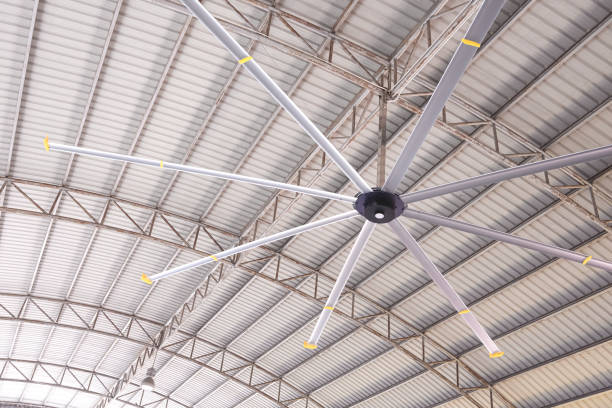
Dust and Particles
Dust and particulate matter emitted during grinding, cutting, and material handling are deposited on equipment and lead to wear, and are inhaled by workers, raising risks of respiratory problems such as silicosis. Lack of airflow means the particles stay suspended, which contravenes the air quality requirements and reduces the precision of machines.
Safety Issues from Poor Airflow
Poor ventilation increases heat strain, which results in a 20 percent rise in accidents, according to OSHA statistics. Lack of visibility due to smoke and stagnant air areas increases the danger of condensed slips, particularly on metal floors, undermining work safety.
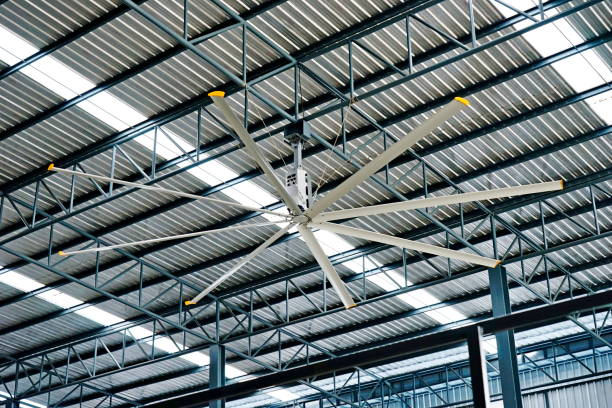
How Ceiling Fans Address These Challenges
With a diameter of 8-24 feet, HVLS ceiling fans rotate up to 400,000 cubic feet per minute at lower speeds (50-100 RPM), and provide customized solutions to welding cooling requirements.
Large Air Circulation to Disperse Fumes
HVLS fans produce extensive air movement, 10,000-22,000 square feet per unit, which is effective at diluting the welding fumes and smoke by 15-20%. This helps control fans in fume control workshops to force the contaminants to exhaust systems and lower them to levels below the OSHA PELs. Fans cleared smoky areas in a welding shop, and the air quality improved after 10 minutes of operation.
Safer Working Temperatures
HVLS fan wind-chill reduces apparent temperatures by 5- 10 °C, reducing heat stress. Fans can achieve uniform conditions by destratification of air, or mixing warm air at the ceiling with colder air at the floor, in line with ASHRAE Standard 55 on thermal comfort. This minimizes worker fatigue and heat incidents.
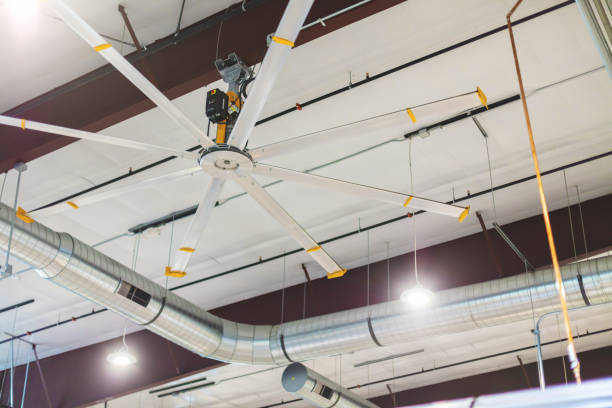
Reducing Stagnant Air Zones
Unlike other fans, HVLS fans remove stagnant areas that store smoke and particles and allow a uniform air flow throughout working areas. This industrial protection of ceiling fans ensures the accumulation of dust that does not harm the working people or the operation of the equipment.
Protecting Equipment from Overheating
The fans increase the minimum temperature in the air space surrounding the machines, lowering the chances of overheating by 10-15 per cent. This prolongs equipment life, as in factories where CNC machines would be more reliable after adding fans.
Worker Comfort & Safety
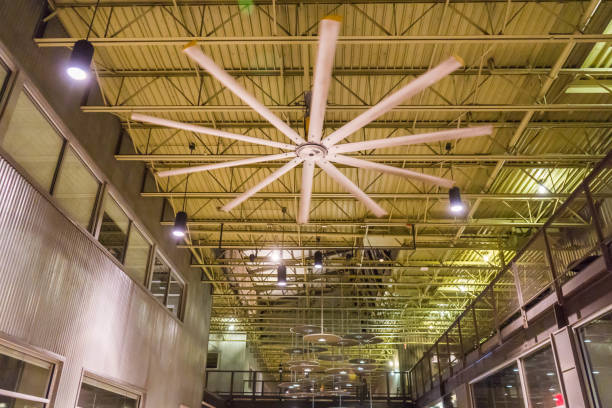
HVLS fans improve the working conditions and adherence to safety standards.
Lower Fatigue and Accidents
According to OSHA studies, heat stress decreases productivity by 2 percent per degree over 77 degrees Fahrenheit (25 degrees Celsius). HVLS fans enhance the comfort of industrial ceiling fans, reducing the potential errors in fatigue by 15-20. An assembly facility had reported a 10 percent reduction in the number of accidents upon installation of fans.
Better Visibility with Reduced Smoke
Fans enhance visibility by spreading smoke, which is 20% better than in the case of precision welding. This reinforces OSHA safe workplaces through the General Duty Clause.
Compliance with Safety Regulations
Fans comply with OSHA ventilation (29 CFR 1910.94) by ventilating and keeping the temperatures safe. They have UL/ETL certifications that ascertain adherence to machine safety requirements (29 CFR 1910.212).
HVLS Fans vs Other Ventilation Systems
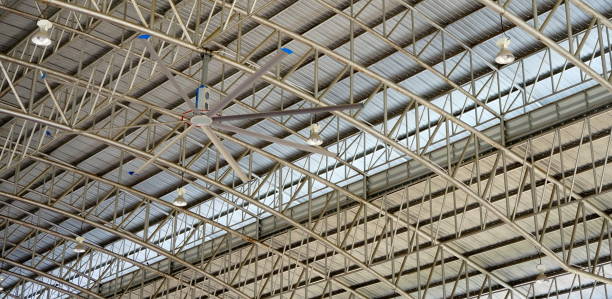
The HVLS fans are more effective than other systems in the welding workshop:
- Local Fume Extractors: Local fume extractors are effective in point-source fume removal but can only cover small areas and are expensive (between $5,000 and 10,000/unit). HVLS fans offer facility-wide fume control workshop fans.
- Small Fans: Wall or floor fans (60-70 dB) are loud and have a smaller area coverage (1,000-3,000 square feet) and a requirement of many fans. HVLS fans are noisier (less than 35 dB).
- HVAC Systems: require complex ducting and consume 50-200 kW, but HVLS fans consume 1.5 kW and complement HVAC, reducing energy consumption by a factor of 20-30.
HVLS fans are better ventilators than other fans due to their better coverage and efficiency.
Practical Example: A Welding Shop Transformation
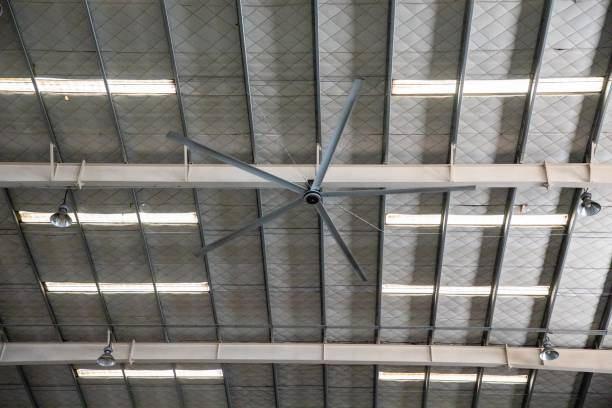
A 15,000-sqft welding shop also had a problem with smoke accumulation and heat stress, which resulted in a 20 percent productivity loss and numerous employee complaints. By replacing 12 loud floor fans (65 dB) with three 18-foot HVLS fans, noise was cut to 35 dB, smoke clearance was increased by 15 percent, and perceived temperatures dropped by 7 degrees Celsius. The increase in productivity grew by 18 percent, the reduction in absenteeism by 10 percent, and the reduction in energy expenses by 25 percent ($5,000/year). This demonstrates the role of ceiling fans in making welding shops safe and efficient.
FAQ: Common Questions About HVLS Fans in Workshops
- Can ceiling fans replace fume extractors?
No, but HVLS fans are complementary in that they spread fumes throughout the facility, complementing fume control workshop fans and decreasing concentrations. - Are HVLS fans safe to use around welding sparks?
Yes, the HVLS fans are safe in spark-prone conditions with UL/ETL qualifications and robust materials. - Do fans affect the stability of welding arcs?
No, the soft air current by HVLS fans will not interfere with arcs and give the most accurate welding with the optimum ventilation of heavy-duty workshops. - How do HVLS fans improve worker safety?
Fans comply with OSHA regulations by alleviating heat stress, fumes, and the risk of slipping, which contributes to the safety of industrial ceiling fans.
Conclusion
The extreme heat, fumes, and safety concerns is also a challenge to the welding and heavy-duty workshops and the high-oil heavy-duty workshop ventilation that has been provided by welding workshop ceiling fans, particularly the HVLS type. They improve productivity and compliance, improving the air flow, reducing the heat stress, and locking the equipment. The workshop managers can be advised to include industrial ceiling fans in the ventilation systems in order to achieve the safety and efficiency goals. The experience of the RTFANS (20+ years) grants the custom HVLS fans industrial workshops. Write to us now, and make a change in your shop- your men and your work deserve it.
